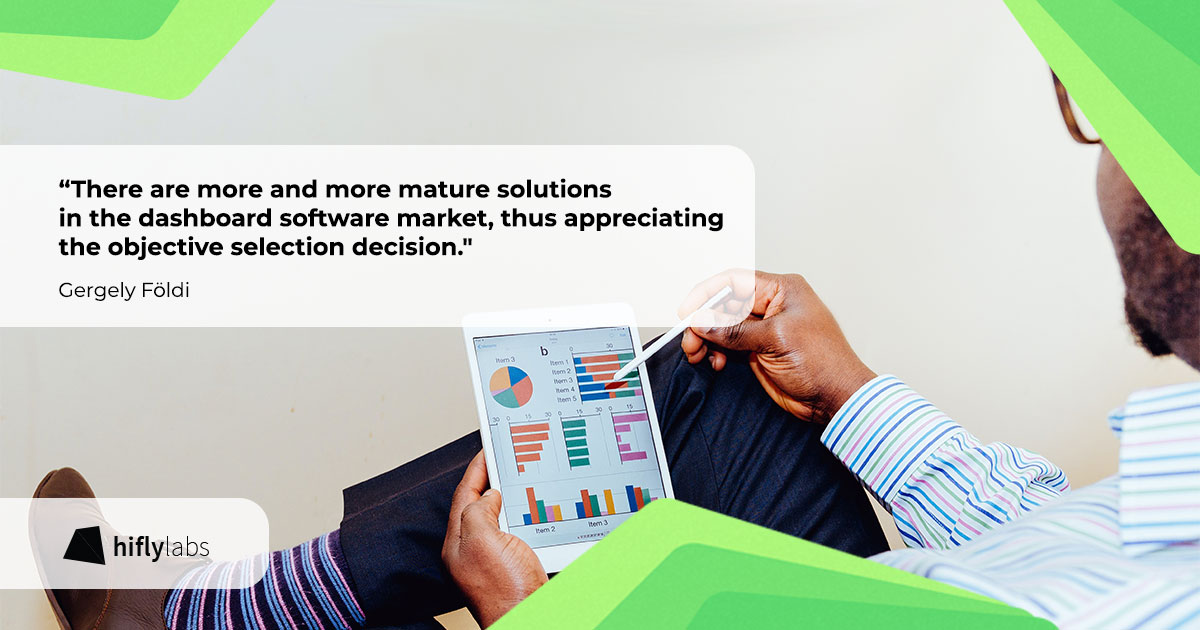Reading time: 4 min

“No love at first sight!” In a nutshell, that would be our recommendation when it comes to choosing a self-service BI tool for an organization. Let’s collect the business requirements and decision objectives first, then explore your options.
In our previous blog post, we discussed some decision objectives related to self-service BI tool selection. Now, we will focus more on some specific software.

We will share some detailed experience on well-known offerings (Tableau, Power BI, Qlik) and we will introduce other software options as well. Moreover, we will touch upon the role of open-source software.
Disclaimer: The content of this article is based on our project experience and in-house testing. There is no one-size-fits-all solution. As an independent IT provider, we have no interest in promoting any software. This article was written to be a new narrative besides the well-known market researchers and product descriptions.
The three names, we should have a word on
There is a high chance that youalready heard about Tableau, Power BI and Qlik even if your are just starting getting to know what self-service BI is. This three vendors are well-established members of the Gartner Magic Quadrant for Analytics and Business Intelligence Platform, usually as leaders.
Tableau
+ Exceptionally good at data exploration tasks
+ The default stylish appearance is guaranteed
+ Strong community and support
– Learning may be difficult for an inexperienced user
(But later on the software gets very intuitive)
Conclusion: In general, Tableau has a solution for almost any needs. It is under continuous development in a very innovative way. Quality product but it comes at a price.
Power BI
+ Very versatile tool with good data exploration and dashboarding capabilities
+ For a frequent Microsoft product user, it is truly logical
+ Under very dynamic & user demand focused product development
(New version every 2-months or so)
+ Strong community and support
– The general appearance is plain (but very customizable)
Conclusion: Just a Microsoft product, it has a great market fit. The cloud pro user license is reasonable. The premium license targets big organizations. In the recent year, Microsoft tends to move its user base to the cloud and Power BI goes along with it.
Qlik (Sense*)
+ Data preparation, data transformation (ETL) functionalities are strong
+ Good at dashboarding and reporting
– Not particularly good at data discovery
– Weaker community and the available documentation content is not always helpful
Conclusion: It is recommended when you have regularly updated dashboards and you want to implement some complex data transformation logic within your BI tool.
Although Gartner also refers to it only as Qlik, in fact, the company has a whole family of products. The above points apply to their Qlik Sense product.
Other promising players
Besides the three leaders, we recommend having a look at the market. Considering your existing IT stack, the pricing or other factors, you could find a better option among these players regarding your specific use case.
- Oracle Analytics: Good match with Oracle IT stack
- SAS Visual Analytics: Good match with SAS IT stack
- Looker: If your IT architecture is built on the cloud
- Data Studio: Online marketing use cases
Obviously, the above list is far from complete. With special use cases, other options should be further investigated.
Are open-source solutions real alternatives?
Open-source comes to the picture when it comes to data visualization. Just to mention a few: ggplot, plotly, matplotlib and bokeh. They are popular, first of all, because of the free access but superb customization or existing IT architecture can be also a driver towards open-source.
On the field of dashboard building, Shiny (R background) and Plotly Dash (Python background) could be two alternatives of self-service BI tools which we previously discussed. However, our opinion is that they are simply not playing the same game, as they do not target the same user needs:
- Using Shiny or Plotly Dash the dashboard developer should have some level of programming affinity. In contrast, the self-service tools are built specifically for business-minded developers.
- The financial question whether we want to spare on software licensing and user training in exchange for the open-source developer wage and the hosting of the solution.
- Here (again), there is no one-size-fits-all solution. The use-case drives the optimal solution.

The best solution is…
Not existing. It depends on the use-case.
That is why the preliminary and comprehensive user specification with real use-cases and real end-users is so critical.
We highly recommend trying out the trial version of a few selected software. Thus, with a proof-of-concept approach, you can easily discover the capabilities of the tools with your specific needs.
Finally, we should always keep in mind that the self-service BI tool is just one of the several factors which drive the data-driven culture of our organization. High-level management support, effective competency management, the data technology stack also have a strong influence on the cultural shift.
Földi Gergely – Dashboard and data warehouse developer
